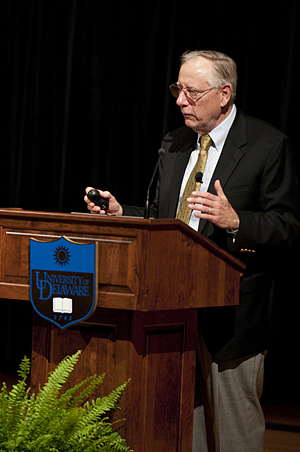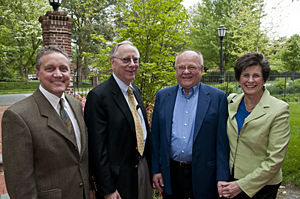ADVERTISEMENT
- Rozovsky wins prestigious NSF Early Career Award
- UD students meet alumni, experience 'closing bell' at NYSE
- Newark Police seek assistance in identifying suspects in robbery
- Rivlin says bipartisan budget action, stronger budget rules key to reversing debt
- Stink bugs shouldn't pose problem until late summer
- Gao to honor Placido Domingo in Washington performance
- Adopt-A-Highway project keeps Lewes road clean
- WVUD's Radiothon fundraiser runs April 1-10
- W.D. Snodgrass Symposium to honor Pulitzer winner
- New guide helps cancer patients manage symptoms
- UD in the News, March 25, 2011
- For the Record, March 25, 2011
- Public opinion expert discusses world views of U.S. in Global Agenda series
- Congressional delegation, dean laud Center for Community Research and Service program
- Center for Political Communication sets symposium on politics, entertainment
- Students work to raise funds, awareness of domestic violence
- Equestrian team wins regional championship in Western riding
- Markell, Harker stress importance of agriculture to Delaware's economy
- Carol A. Ammon MBA Case Competition winners announced
- Prof presents blood-clotting studies at Gordon Research Conference
- Sexual Assault Awareness Month events, programs announced
- Stay connected with Sea Grant, CEOE e-newsletter
- A message to UD regarding the tragedy in Japan
- More News >>
- March 31-May 14: REP stages Neil Simon's 'The Good Doctor'
- April 2: Newark plans annual 'wine and dine'
- April 5: Expert perspective on U.S. health care
- April 5: Comedian Ace Guillen to visit Scrounge
- April 6, May 4: School of Nursing sponsors research lecture series
- April 6-May 4: Confucius Institute presents Chinese Film Series on Wednesdays
- April 6: IPCC's Pachauri to discuss sustainable development in DENIN Dialogue Series
- April 7: 'WVUDstock' radiothon concert announced
- April 8: English Language Institute presents 'Arts in Translation'
- April 9: Green and Healthy Living Expo planned at The Bob
- April 9: Center for Political Communication to host Onion editor
- April 10: Alumni Easter Egg-stravaganza planned
- April 11: CDS session to focus on visual assistive technologies
- April 12: T.J. Stiles to speak at UDLA annual dinner
- April 15, 16: Annual UD push lawnmower tune-up scheduled
- April 15, 16: Master Players series presents iMusic 4, China Magpie
- April 15, 16: Delaware Symphony, UD chorus to perform Mahler work
- April 18: Former NFL Coach Bill Cowher featured in UD Speaks
- April 21-24: Sesame Street Live brings Elmo and friends to The Bob
- April 30: Save the date for Ag Day 2011 at UD
- April 30: Symposium to consider 'Frontiers at the Chemistry-Biology Interface'
- April 30-May 1: Relay for Life set at Delaware Field House
- May 4: Delaware Membrane Protein Symposium announced
- May 5: Northwestern University's Leon Keer to deliver Kerr lecture
- May 7: Women's volleyball team to host second annual Spring Fling
- Through May 3: SPPA announces speakers for 10th annual lecture series
- Through May 4: Global Agenda sees U.S. through others' eyes; World Bank president to speak
- Through May 4: 'Research on Race, Ethnicity, Culture' topic of series
- Through May 9: Black American Studies announces lecture series
- Through May 11: 'Challenges in Jewish Culture' lecture series announced
- Through May 11: Area Studies research featured in speaker series
- Through June 5: 'Andy Warhol: Behind the Camera' on view in Old College Gallery
- Through July 15: 'Bodyscapes' on view at Mechanical Hall Gallery
- More What's Happening >>
- UD calendar >>
- Middle States evaluation team on campus April 5
- Phipps named HR Liaison of the Quarter
- Senior wins iPad for participating in assessment study
- April 19: Procurement Services schedules information sessions
- UD Bookstore announces spring break hours
- HealthyU Wellness Program encourages employees to 'Step into Spring'
- April 8-29: Faculty roundtable series considers student engagement
- GRE is changing; learn more at April 15 info session
- April 30: UD Evening with Blue Rocks set for employees
- Morris Library to be open 24/7 during final exams
- More Campus FYI >>
8:54 a.m., April 30, 2010----The opening of the Second Blue Water Bridge, between Port Huron, Mich., and Point Edward, Ontario, in 1997, marked the culmination of years of work on a new design code aimed at providing uniform safety by using a statistical basis for linking the loads on a bridge to its resistance, or ability to withstand that load.
John Kulicki, chairman and CEO of Modjeski and Masters in Mechanicsburg, Pa., was a key player in the development of that code, the AASHTO Load and Resistance Factor Design (LRFD) methodology, which has gradually replaced more traditional design approaches. He shared the history of the LRFD with an audience of more than 200 during the fifth annual Arnold D. Kerr Lecture in Engineering Mechanics and Design at the University of Delaware on Wednesday, April 28.
Despite his conviction that the LRFD is a robust design approach, Kulicki reminded the attendees, many of whom were engineering students, that design codes are not perfect.
“There's a tendency for young engineers to think that these codes are divinely inspired,” Kulicki said, “but nothing could be farther from the truth. They're developed by people and implemented by people. There is no perfection in the real world. Our goal is to keep the risk tolerably small while still building bridges affordably.”
Kulicki likened the development of the new code to the evolution from DOS to Windows in the PC world. “Adoption of the LRFD represented a switch to a more robust, more expandable platform,” he said. “And as with the changeover to a new computer operating system, there was a learning curve and some headaches during the transition, but its benefits and logic have become apparent over time.”
The process, however, was long and at times tedious. Kulicki said that the committee writing the specifications received 12,000 comments from the hundreds of people who reviewed the four drafts of the document.
Even since its official adoption, the code has undergone multiple iterations to accommodate such issues as heavier trucks and new construction materials. For example, in 2007, the seismic specifications were modified, and in 2008 a new specification was developed for hurricane loads on coastal bridges.
A major issue that remains to be addressed is scour, a term used to refer to the removal of founding materials from around bridge abutments or piers by rapidly moving water. Scour scoops out holes around these structures, compromising the integrity of the bridge. “Everything else pales in comparison to what dirt does in the face of water,” Kulicki said.
He also admitted that the design code project will probably never be truly finished. “We follow nature in our learning. Every time there's an earthquake, we learn something new. So there are probably other things missing from the code -- we just don't know what they are yet.”
To demonstrate the code's evolution, he showed photos of the 2004 version, at 500 pages, and the 2009 version, at 900 pages.
His next slide? A picture of a handcart, which Kulicki said may have to replace the three-ring binder in the future as more details are added to the specifications.
A graduate of Lafayette College and Lehigh University, Kulicki has more than 35 years of experience in virtually all aspects of bridge analysis and design. He was elected to the National Academy of Engineering in 2006 for “the design of major bridges and for leadership in the development of load and resistance factor design specifications.”
Sponsored by UD's Department of Civil and Environmental Engineering, the lecture series was initiated in honor of Arnold Kerr, professor emeritus of civil engineering, upon his retirement in 2004. Kerr is an internationally recognized expert in engineering mechanics, with a particular focus on railway engineering.
Article by Diane Kukich
Photos by Doug Baker




